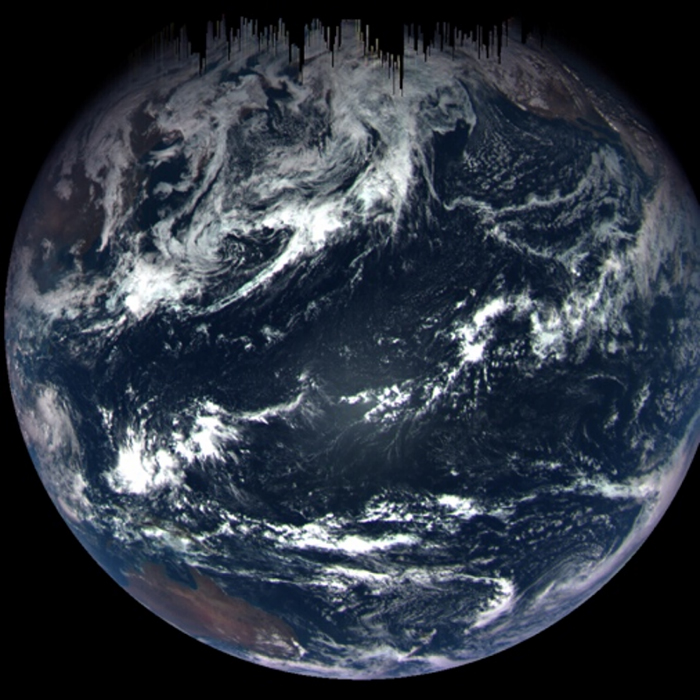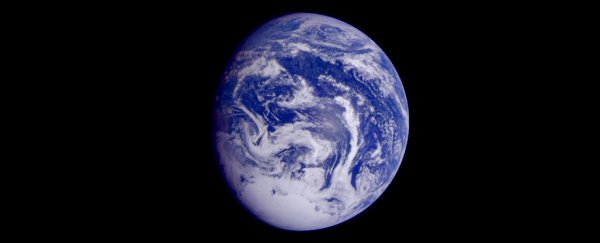By applying methods used to evaluate the chances of life on other planets, scientists have concluded that Earth is indeed inhabitable – but it's also becoming increasingly polluted by levels of carbon dioxide and methane.
The inspiration for the new research is an experiment run by Carl Sagan and his team back in the early 1990s, which used the launch of the Galileo spacecraft to examine what our alien-spotting instruments would make of the chances of life on Earth.
Galileo was on its way to Jupiter to make similar assessments further out in space. This time, the probe in question was the OSIRIS-REx, launched by NASA last year on a mission to investigate the composition and path of the Bennu asteroid.
 Image taken by OSIRIS-REx. (NASA)
Image taken by OSIRIS-REx. (NASA)
"It's a challenging intellectual enterprise," Dante Lauretta, from the University of Arizona in Tucson and principal investigator of the OSIRIS-REx mission, told Katherine Kornei at Science. "I really tried to channel Carl Sagan."
A quarter of a century ago, Sagan noted "evidence of abundant gaseous oxygen", atmospheric methane, signs of vegetation, and the detection of radio signals as evidence that intelligent life existed on Earth.
Of course we already knew it did – but the point of the experiment was to put Galileo's life-detecting capabilities through a detailed test before it started its more serious work.
This time around, Lauretta and the OSIRIS-REx team found the spectrograph readings again picked up high levels of methane, oxygen, and ozone, much higher than would be expected on a lifeless planet.
These gases, detected by OSIRIS-REx through the absorption of light at different wavelengths, are indicative of biological processes on a planet's surface. The team also found evidence of photosynthesis and water, though no direct evidence of ice (as the poles were out of view).
In other words, an alien being with nothing to go on except the readings from this spacecraft, could be reasonably sure that life was thriving on Earth.
While it'll be a relief to us all that we are in fact alive and on a habitable planet, the research did reveal some more troubling findings too.
Methane and carbon dioxide levels are 12 percent and 14 higher respectively than they were in Sagan's first experiment, showing some the impact of an extra two billion people on the planet.
It's another reminder of the challenges we face to keep Earth as conducive to life as it is at the moment.
Having tested its skills on our home planet, the OSIRIS-REx probe now continues its journey towards the Bennu asteroid, which it's expected to reach in August 2018. It'll be studying the flying space rock for signs of organic compounds, similar to those that may have sparked life on Earth.
Bennu is also noticeable for having a 1-in-2,700 chance of smacking into Earth at some point in the future, but don't worry – scientists are keeping a close eye on it.
Part of the job of OSIRIS-REx is to get the latest readings on the trajectory of Bennu, so we can better assess how real the threat is. In the unlikely event that we do need to deal with an asteroid hit, this one won't be until well into the 22nd century.
This new study could also help inform our efforts to scan for signs of life on distant exoplanets – if other beings are out there then we need to know how to find them, and Earth can help with that, according to Sarah Stewart Johnson from Georgetown University in Washington, DC, who wasn't involved in the latest research.
"These images and spectra underscore the dazzling possibilities for exoplanets," she told Science.
The findings were presented at the Lunar and Planetary Science Conference in The Woodlands, Texas, and can be read online.
